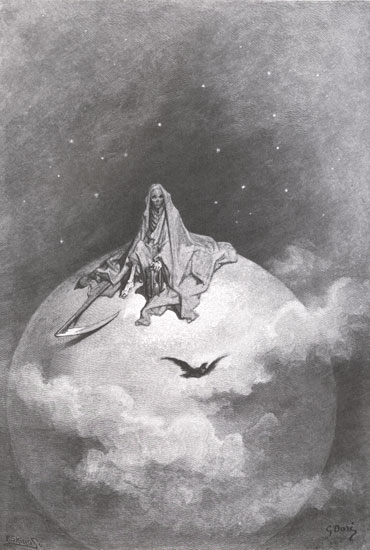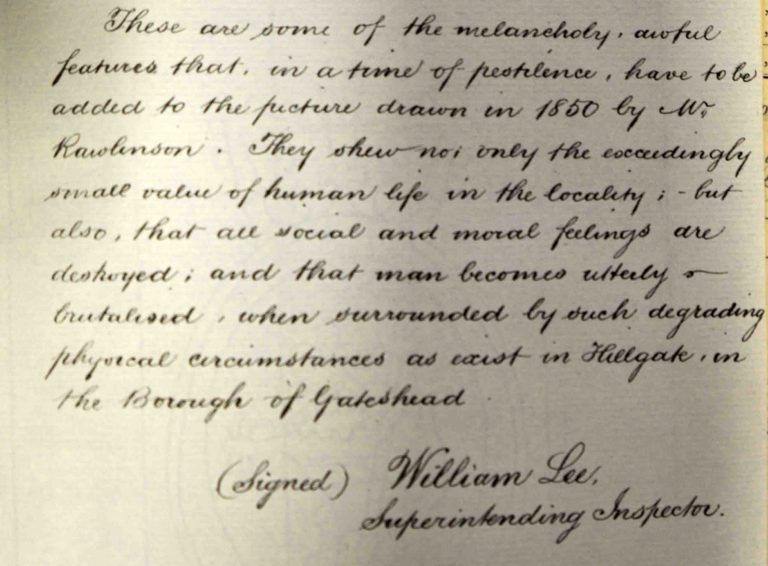
Illustration 11 of Edgar Allan Poe’s Raven by Gustave Dore, under Creative Commons: http://commons.wikimedia.org/wiki/File:Paul_Gustave_Dore_Raven1.jpg
Halloween may traditionally be considered to be the time of the year when the veil between the physical and non-physical worlds is thinnest, but in the mid-nineteenth century that veil often seemed permeable. As Britain struggled to balance its desire to exploit the advantages of the industrial revolution with its ability to cope with the effects of such immense socio-economic upheaval, unearthly forms of abject misery became a troubling by-product of Victorian progress.
During this period, government health policy was implemented at a national level. This led some of those experiencing or witnessing the worst of times (frequently the result of the poor sanitation associated with overcrowded and often wretched living conditions), and who believed that they could be better times, to ask those in power for assistance. The response often came in the form of a public inquiry, conducted ‘on the spot’ by a Superintending Inspector sent by the government.
The inspector would look into the sewerage, drainage, supply of water, state of burial grounds and other matters relating to the sanitary condition of the borough or parish in question, before submitting his recommendations for improvement to the Home Secretary. As a result, we have inherited a series of records that captures the response of not just the nation, but of the city, town, village and the individual to the realities of health, contagious disease and sanitation provision during the nineteenth century.
That record series is MH 13: General Board of Health, 1848-1858 and Home Office, Local Government Act Office, 1858-1871. The records contain correspondence relating to the provision and administration of public health, sanitation and other services under the several Public Health and Local Government Acts passed between 1848 and 1871.
Exploding coffins and abandoned corpses
Much of the disorder, squalor and decay that is documented within MH 13 reminds me of the world so powerfully depicted by the great urban novelist and social commentator of the day, Charles Dickens. In fact, Dickens’ younger brother, Alfred, was one of the Consulting Engineers employed by the General Board of Health as a Superintending Inspector. His handwritten reports can be found within a number of the volumes of MH 13. In 1857, for example, Dickens was sent to report upon the sanitary condition of Glossop in Derbyshire, where, at the back of six ‘decent cottages, moderately well kept’, he found an open cesspool ‘filled with refuse of a very foul description, in which are floating heaps of corruption’. Among the ‘putrefying masses’ Dickens reports that he counted ‘no less than five bodies’ (MH 13/78/13).

Signature of Alfred Lamert Dickens, Superintending Inspector and brother of Charles Dickens. Catalogue reference: MH 13/78/13
In 1853 William Lee, a contemporary of Alfred Dickens and fellow Superintending Inspector, was sent by the General Board to report on an outbreak of cholera in the district of Gateshead, Durham. Lee remarks upon ‘the quietness resulting from an almost entire cessation of business traffic’. He notes the absence from the district of all respectable persons, ‘except those whom imperative duty required to be there’; ‘the anxious importunity of wretched, half-clad females soliciting the means of drowning their excitement in intoxication’ and ‘the panic stricken countenances of others who had lost all power of motion from fear’. He describes being followed by mistake along the streets and asked for medicine ‘by human beings, alive, but already touched by the finger of the Destroyer, and destined in all probability to be soon numbered among the victims’. He adds that ‘among the chief sounds that meet the ear are the moans and the bitterness of the bereaved husbands and wives, parents and orphans’ (MH 13/77/207). A similar set of circumstances was found at Hadley Common, Enfield around a year later. A local Inspector of Nuisances, G Milroy, reports that one area, Mill Corner, had become ‘such a nest of sickness and vice’ that it had come to be known locally as ‘Hell Corner’ (MH 13/69/60).

William Lee’s concluding remarks on an inspection of Gateshead, Durham in 1853. Catalogue reference: MH 13/77/207.
Travelling during an outbreak of cholera was a decidedly risky affair. Take, for example, the case of Mrs Price of Gloucester, who despite (or perhaps because of) the employment of brandy, ‘starch and opium by the rectum, calomel and opium by the stomach and mustard poultice to the epigastrium’ did not rise again after returning home from a fateful trip to Southwark (MH 13/78/188). There is also the shocking story of Edward Prettejohn, a cider merchant from Totnes, Devonshire, whose corpse ended up resting on the platform of Totnes Station for 5 hours (MH 13/60/134). And one particularly harrowing tale is that of the son of a schoolmaster who ended up ‘a corpse’ within 24 hours of arriving at Steeple, Essex from Bermondsey, and whose niece, also ‘supposed to be dead’, dramatically opened her eyes whilst being measured for a coffin (MH 13/230/190).
Perhaps most shocking of all, however, is what took place in the basement of Queen-Street Chapel, Huddersfield, in 1851. This time William Lee had been sent to investigate the state of the burial grounds in the town. Upon entering the vaults of Queen-Street Chapel he found that ‘the expansive power of the gases resulting from decomposition had not only burst the cement joints of the flagstones forming the cases around the coffins, but in one instance the stone itself had burst’. In short, the coffins were exploding (MH 13/95/14).
MH 13 cataloguing project: Death, dirt and disease
MH 13 is currently undergoing something of a revival of its own, at least in terms of the way that it is catalogued. Up until now it has only been possible to search the records via the names of the urban or rural districts that are included within the series. To improve the accessibility of the individual handwritten letters, reports, petitions, printed pamphlets, posters and newspaper cuttings that make up each of MH 13’s 272 volumes, we have been working to catalogue a significant portion of the series piece by piece. This work (funded by the Wellcome Trust) means that sophisticated key word searches, drawing on the detailed content of each individual item, will now be enabled within Discovery.
The proper cataloguing of MH 13 is not only opening up what was once an impenetrable set of records, but is also ‘lifting the veil’ on previously hidden elements of our domestic medical history. This enables us to glimpse the conditions in which the nineteenth century working and middle classes actually lived, in the ways that they chose to describe them. Perhaps then, it really doesn’t need to be Halloween for those who have long since passed to feel closer to us all…
Wow ! This reads like fiction rather than fact. Truly fascinating.
Fantastic blog Mark. Really shows how useful the MH 13 records are for C19th social history, and, unfortunately, goes to show that Alfred Dickens’ brother wasn’t embellishing the truth too much in his portraits of squalid Victorian living conditions…